Cognitive Style in Creative Work: The Case of the Painter George Rodrique
by
Subrata Dasgupta
January 1, 2005
A creative person’s cognitive style consists of particular features or regularities that appear to underpin his or her cognitive processes of creation. In a previous paper we had studied the cognitive style of a multidisciplinary scientist, Herbert A. Simon (Dasgupta, 2003a). In this paper we use the method of cognitive history combined with in vivo study to examine the cognitive style in the creative work of a contemporary artist, George Rodrigue. Such specific case studies are valuable in that they allow us to compare cognitive styles across the spectrum of creative work, and thereby find both similarities and differences between them.
The main elements of Rodrigue’s cognitive style were found to be as follows : (a) the invention of several schemas; (b) a strategy of schemas interrupting and interacting with each other; (c) the use of forms, colors and particular pictorial entities as symbolic representations of feelings, emotions and expressions; (d) a knowledge system and worldview that encoded a strong sensibility toward local history, geography and culture; (e) a strategy for bisociative synthesis.
Some of these elements are not unique to Rodrigue; but rather, it was the way these elements were combined that characterized the uniqueness of the artist’s cognitive style. Furthermore, Rodrigue’s cognitive style had both a prehistory and a developmental history.
1. Introduction
Generally speaking, a person’s ‘style’ designates certain idiosyncratic features, patterns, and regularities that characterize a person’s way of thinking, reasoning and/or doing. More specifically, a person’s cognitive style is a compendium of identifiable patterns or regularities characterizing the goals, knowledge and reasoning he or she brings to bear in the course of cognitive processes. An individual’s cognitive style is an abstraction of her cognitive processes and is, thus, more accessible to inquiry than the cognitive processes themselves. Because of this, the study of cognitive style is of particular interest to those who wish to understand the nature of creative minds — as much in the sciences (Dasgupta 1999, 2003a, 2003b; Davidson, 1999; Holmes, 1989) and design (Simon, 1975; Dasgupta, 1991) as in the arts (Gaiger, 2002; Gombrich, 1969, pp 3-32; Robinson, 1981; Wollheim, 1984, pp 25-84).
In an earlier work, we had examined in detail the cognitive style of the polymath scientist Herbert A. Simon (Dasgupta, 2003a). Our aim there was to understand Simon’s multidisciplinary creativity in terms of his cognitive style.
In the present paper we turn our attention to the creative mind of a contemporary artist, George Rodrigue (b. 1944). While psychologists, psychoanalysts and other art scholars have studied the styles of many artists (see, e.g., Arnheim, 1962; Freud, 2001; Kris, 1952; Miller, 2001; Rubin, Seckel & Cousins, 1994; Wollheim, 1984) the work presented here is distinguished because of its explicitly cognitive approach. We claim that this approach has yielded a sharper insight into a contemporary working artist’s cognitive style precisely because of its appeal to concepts drawn from cognitive science. This does not imply we reject or ignore the psychoanalytic and art-historical writings. Rather, we also draw upon them for their particular insights and as corroborative support for our cognitive analysis. And, as we shall see, in the realm of creative work, especially as it relates to art, the cognitive and the affective cannot be demarcated. In the case of George Rodrigue, his emotions and feelings about his culture and the environment in which he was raised strongly informed the thinking that went into his art.
2. The cognitive-historical-anthropological case study approach
The way a person thinks about his work, the way he perceives nature, humanity and culture, the way he draws upon his worldview, knowledge and memory (including autobiographical memory), the way in which he reacts aesthetically and emotionally to related work of the past and present, the reasoning he employs, the symbols and metaphors he invents and deploys — these all contribute to a person’s cognitive style.
While one can learn a lot about an individual’s cognitive style from her finished works, there are limits to the insight that is yielded by the visible works alone. One needs to penetrate the individual’s thoughts, her vision, her values, her beliefs — her knowledge system and worldview, in other words — through other means: published writings, letters, jottings, notes, diaries, interviews (if she is still living), and so on. Toward this end, the method of cognitive history affords an investigative method into cognitive style.
The term ‘cognitive history’ refers to a program of inquiry that (a) attempts to understand aspects of, and episodes in, the history of the creative tradition from a cognitive perspective, and (b) draws on historical and biographical studies of creativity to shed light on the cognitive nature of the creative process (Nersessian, 1995; Dasgupta, 2003a).
It is the most obvious strategy to use when one is interested in some seminal act of creation performed by a specific individual (see, e.g., Gruber, 1974; Tweney, 1989; Ippolito & Tweney, 1983; Dasgupta, 2003b). It is also an invaluable approach for shedding light on the mechanics of a particular genre of creativity, as in technology, science or literature (Holmes, 1989; Jeffrey, 1989;Weber & Perkins, 1992). Elsewhere, we have also applied it to obtain the empirical evidence to test (and refute) a particular theory of the creative process (Dasgupta, 2004).
Our objective here is to apply the method of cognitive history to the genre of art — in particular, to examine how we may use this approach to understand the cognitive style of the artist George Rodrigue. However, in the case of a living subject — as is the case with Rodrigue -- we may broaden the notion of cognitive history to include an anthropological strategy. In Rodrigue’s case, we not only appealed to the historical and biographical evidence, but were also able to observe him at work. It is for this reason, our present approach may be more accurately termed a cognitive-historical-anthropolgical approach.
Discussing an artist’s cognitive style is complicated by the need to refer to his or her products — in Rodrigue’s case, his paintings and silkscreens. In this paper, we illustrate aspects of his cognitive style in part by incorporating images of some of his works as part of the text itself; we also cite some of the pictures by referring to reproductions in publications on Rodrigue’s work (Freundlich, 1996; Danto & Rodrigue, 2003).
A cognitive style does not appear in one fell swoop. It evolves into existence and may undergo constant revision over a period of time till it reaches a state of maturation. Moreover, one’s cognitive style has a ‘prehistory’.
In the realm of creative work, this prehistory takes the form of preparation. Wallas (1926) viewed preparation as a kind of intellectual history of the thinking, creating person which prepares her to take up creative work. "Preparation... includes the whole process of intellectual education" (p. 82). Here, preparation is the conscious ‘proactive’ construction of the potential for future acts of creation. We will call this proactive preparation.
‘Formal’ education is one of the means of attaining a prepared mind, but it is only one such means. Nor is it a necessary means. Creative people usually go well beyond what formal education can offer. They not only saturate themselves with knowledge in their chosen field but also become enriched with knowledge of other fields. They are often autodidacts. They establish for themselves certain goals and values that formal education alone can rarely induce in them. They observe, read widely, take note of ideas and things. They gather experiential knowledge.
It is easy to understand why proactive preparation is a prerequisite for creative work; the latter is a knowledge-rich enterprise — and this as true in art as it is in science. As Kris (1952, p. 21) noted, artists do not produce "in an empty space"; they are no less dependent on their predecessors for ‘models’ and ideas than are scientists and philosophers. For example, Lowes’s (1927) classic study showed how Coleridge’s poems Kubla Khan and Rime of the Ancient Mariner drew on a rich and intricate corpus of sources, while Picasso’s Demoiselles d’Avignon has elicited a large literature on the ‘sources’ of this painting (Rubern, Seckel & Cousins, 1994). Thus, the issue is not the fact that creative work in art demands proactive preparation, but in what particular way does the prepared mind enter into it? In what particular way does the prepared mind influence the cognitive style of an artist?
The case of George Rodrigue For George Rodrigue, born in 1944 and growing up in South Louisiana, preparation began more or less when he realized that he possessed the gift of art. By the time he was in the third grade, he knew he wanted to be an artist, and in this he received encouragement and practical support from his parents. [1] Formal education in art began in 1954-55 with art classes in school and then with private lessons in 1956-58. In high school he took an art course by mail from a correspondence school based in Minneapolis, Minnesota. In 1962-64, he studied art at the University of Southwestern Louisiana [2] before moving to the Art Center College of Design in Los Angeles, which he attended 1965-67. [3]
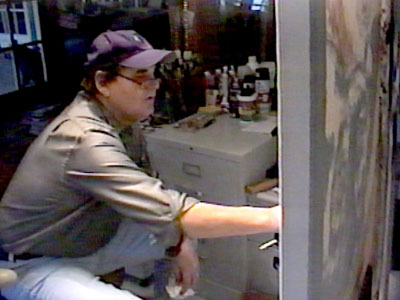 |
In the course of his formal education, Rodrigue honed his skills as a draftsman and in drawing and with paint. He experimented with various techniques, styles, media and forms. He learnt to paint in various ‘general styles’ (to use Wollheim’s (1984) term).
[4]
He did figure studies, charcoal studies, quasi-naturalistic landscapes, pen-and-ink drawings, oils; he painted people as well as non-representational works (Freundlich, 1996, pp 48-52).
By his own account, Rodrigue’s time in Los Angeles was spent in intensive study of Pop Art.
[5]
But the focus of the Art Center was commercial rather than ‘fine’ art and so, even Warhol’s paintings and silkscreens were looked upon as graphical works rather than ‘high art’.
[6]
As for Abstract Expressionism, this was also taught in the Art Center but "not in terms of art history... but rather as a discipline".
[7]
While in California, Rodrigue experimented with Pop Art-as-fine art; he did collages; he blended the collage technique with a mix of techniques taken from both Pop Art and Op Art (Danto & Rodrigue, 2003, pp 48-49). In one work of this period, Rodrigue transferred the collage’s cut-and-paste elements entirely to paint (Freundlinch, 1996, p. 52).
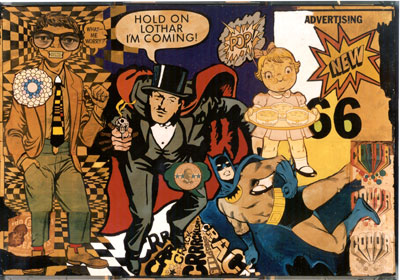 |
Returning to South Louisiana — ‘Cajun Country’ — this experience led Rodrigue to realize that he knew what he would not paint: He would not follow the Abstract Expressionists — "a style within which I never felt comfortable", he would recall in a letter written in October 2001.
[8]
He also turned away from Pop Art, for
I realized I had nothing new to contribute here... it seemed
that my own direction must go elsewhere, lest it appear
I could not find my original way.
[9]
Rodrigue’s "original way" began as far away as one can imagine from both the sophisticated, New York-rooted Abstract Expressionism and the glittering, pop-celebrity, consumer-soaked culture of Warholian Pop Art. It began in the landscape of South Louisiana, a geography in which he had been born and bred and which he knew intimately; and in the history and culture of his, the Cajun, people. His personal knowledge system/worldview was populated by the historical facts, the lores and myths, the cultural traditions and practices of the Cajuns, by the images of the South Louisiana landscape. These experientially gained elements as much prepared him as did his formal training in art school. Together, they pointed him away from the pursuit of Abstract Expressionism and Pop Art toward his root. "I wanted to paint Louisiana", he said, "but in a different way".
[10]
In fact, Rodrigue had reached a state of preparedness which would enable him to create a personal cognitive style that combined disparate aspects of his knowledge system/worldview.
The effective combination of unconnected ideas or concepts in the creative process had been recognized by Henri Poincare in 1915 (Poincare, 1985) but it was Koestler (1964) who coined a word to describe it — bisociation. Koestler associated the act of creation with the unconscious combining of ideas from different "frames of reference" or "conceptual matrices". Bisociation entails the linkage of (at least) two normally incompatible or unrelated matrices.
Rodrigue’s art that would emerge upon his return to Louisiana manifested bisociation. On the one hand, "From Abstract Expressionism training I was very conscious of shapes";
[11]
and from Pop Art there were the techniques of "repetitive imagery" and the use of "a hard edge".
[12]
On the other hand, there was South Louisiana, its culture, history and geography.
I had the experience of California... of looking at art
in a professional way and the newness that was happening
in Pop Art... I had that experience... and I had the
experience of Louisiana... and nobody put those three
mixes together... so it was a completely new idea... if I
had just stuck to Louisiana I would have painted like
anybody... that experience of the three things into one was
what happened.
[13]
He had, Rodrigue added,
... set up my own set of rules and in that way I thought I’m
moving in a direction... I knew that the minute I did it
no one had ever thought of that...
[14]
Bartlett (1932), used the word schema to mean "an active organisation of past reactions, or of past experiences, which must always be supposed to be operating in any well-adapted organic response". This concept has been adopted in more recent times and refined into a ‘schema theory’ (Arbib & Hesse, 1986). According to schema theory, human beings store in their long term memory assemblages of schemas. Beginning in childhood and over time, they constantly construct, use, instantiate and reconstruct their mental store of schemas — which can vary in their specificity. And when a person encounters a new situation, the latter is ‘assimilated’ in terms of some existing schema — which tells her how to respond to the situation or what to expect next.
Schemas are not islands of their own. They are connected to one another, some strongly, others less so, and if a change occurs in one schema this has an impact on some others. The overall network of schemas in one’s long term memory adjusts accordingly.
The schemas people store allow them to live and act in the ‘everyday’ world. One might call them ‘commonsense schemas’ or ‘folk schemas’. In addition, creative people and ‘experts’ possess their own assemblage of schemas that allow them to work effectively in their respective fields. Sometimes, dissatisfied with their repertoire of existing schemas, they invent new ones. This is one of the ways creative people ‘deviate’ from the norm (Gruber, 1989).
Thus, schemas are not fixed entities; they are both elastic and plastic. In assimilating an experience into an existing schema, adjustments may have to be made to the schema. Then there are times when a new experience or situation is seriously at odds with one’s stock of schemas. This might necessitate a radical alteration of an existing schema or the construction of a new one. Gombrich (1969, p. 88) recognized this in the context of art. Influenced by Bartlett, he wrote of art as a process of starting with an initial schema and then ‘correcting’ or modifying it.
For the outsider, Louisiana evokes a stereotypical picture: a land of swamps and Spanish moss, and lazy waterways called bayous. In fact, the physical environment of South Louisiana, the historical land of the Cajun people is all of this but more. There is indeed swampland and bayous, but there is also the great Mississippi River, there are open prairies, and marshland, and raised lands along the rivers called levee land — and each of these natural environments offered its own particular kind of occupation for the Cajuns and others who settled in South Louisiana.
Many artists before George Rodrigue had painted this landscape and, indeed, Louisiana had a long tradition reaching back to the 19th century of landscape painters and photographers (Wiesendanger & Wiesendanger, 1971). Their naturalistic landscapes depict bayous, live oaks, swamps, marshlands and lakeside cabins.
None of these painters, however, was native to Cajun country; some were trained in Europe, like Richard Clague (1821-1873) who had studied at the Ecole des Beaux Arts in Paris. These paintings left George Rodrigue dissatisfied because they missed "the basic traits of South Louisiana" (Rodrigue, 1976). One "basic trait" was a certain feeling the landscape evoked in him, a feeling that had as much to do with his awareness of the history of the Cajun people as with his sensibility to the landscape itself. He wished to see the landscape with his ‘Cajun eyes’; at the same time, he wished to see it with the mind and eyes of an artist who sought to be original.
painter. Well, I want to paint Louisiana... I had painted
abstract things in California. I had experimented with
everything... so what do I paint?... big question... I
didn’t want to paint a bayou scene... when I grew up
everybody was painting a bayou. I didn’t want to paint
a magnolia or a bird...
[15]
The solution did not emerge immediately. At first
I painted landscapes with a lot of stuff in it... but
dissatisfied... then I photographed for a week... I
photographed what interested me... back in the studio
I looked through all these pictures... I realized after
looking at all the photographs that the one thing in all
of them was the tree... the oak tree was the security,
protection, shade, coolness... the tree became the thing
... just the tree...
[16]
But other Louisiana artists had also painted the oak tree. However:
... I went looking at a lot of Louisiana paintings in New
Orleans... the tree was there but at the bottom part of
the paintings... no one had painted the tree as a focus
... so I would paint the whole tree.
[17]
In the "old Louisiana paintings" as Rodrigue remembers them, "the tree was at the bottom".
... so I painted the whole tree... the first symbol — my
painting of the tree became darker and darker it became
an abstract thing — it can be anywhere in a square... an
abstract shape — my tree was moodier, evoking something,
a mystery going on... when I started cutting the top of the
tree — I realized the important thing was the shape and the
sky that was left... then juxtapose the darkest part of the
tree and the lightest part of the sky.
[18]
The tree "became an abstract thing" , "an abstract shape" that could be placed "anywhere in a square". It also "became darker and darker", "moodier, evoking something, a mystery going on". And then when he "started cutting the top of the tree", he "realized [that] the important thing was the shape and the sky that was left (Freundlich, 1996, pp. 21, 37, 59; Danto & Rodrigue, 2003, p. 23).
[19]
In fact, Rodrigue had invented a landscape schema. Its basic features were a dark tree with sharp, staccato-edged lines, a light framed sky, and a dark foreground, These became the "three major positive shapes", "graphic shapes" or "graphic elements" (as he called them) in his work of that period. Furthermore, in creating this schema, Rodrigue appeared to have performed a bisociation — where the unrelated ‘conceptual matrices’ or ‘planes of experience’ (in Koestler’s terms) are, on the one hand, the hard-edged, graphic images Rodrigue had learnt during his proactive preparation and, on the other, his intrinsic familiarity with the landscape itself.
This bisociation did not occur suddenly. Rodrigue’s earliest landscapes, painted in 1969, indicate that the schema evolved into existence. When viewed together they reveal an evolutionary process not in the Darwinian sense, but in the sense of a purposive, gradualistic development (Dasgupta, 2004) in which each step is an experiment, and what the painter learns from each experiment is carried over to the next step. By 1970, the oak tree is not only the central element in Rodrigue’s mental image of his native landscape, it also assumes a harder, more graphic form, with the moss becoming an extension of the branches and defining the shape of the foliage by way of sharp, staccato lines. The moss and the oak became one.
9. Instantiating the landscape schema
Once the schema was in place, Rodrigue returned to it repeatedly, but each time with a different painterly eye. In Study of an Oak Tree (1972)
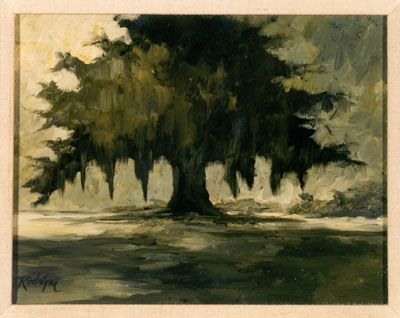 |
, the sky, in green and yellow, has opened up, the speckled green foreground is light, and the trunk of the solitary oak is sharply delineated from the ground. In Sugar Bridge Over Coulee (1973) (Freundlich, 1996, p. 61), the entrapped sky, very small and blue, is given further shape by a bridge interrupting it; the dark foreground is composed of a coulee (another element of the Cajun landscape) and banks on either side; the trunk of the overhanging oak curves as a continuity of the right bank. In Broken Limbs (1975), the tree bends almost wearily; the pale yellow sky is framed by the dominant oak and the lighter-green of the other trees seen in the background.
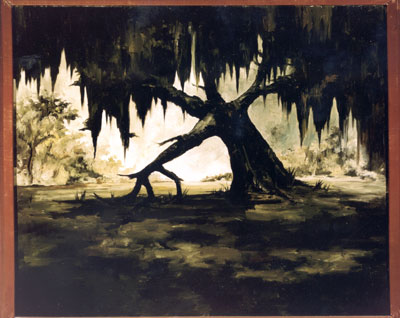 |
Each is an instantiation of the Cajun landscape schema. At the same time, the schema is enriched by each new painterly experience : the various instantiations become new ‘optional’ elements of Rodrigue’s landscape schema; they become ‘subschemas’.
Rodrigue is now more widely known for his ‘Blue Dog’ paintings and silkscreens. These works are also founded on a single schema which constitutes Rodrigue’s second major artistic invention.
As in the case of the Cajun landscape schema, the Blue Dog schema was not invented in one fell swoop. It evolved into existence in the second half of the 1980s. Furthermore, its origins forms a continuum with Rodrigue’s Cajun paintings : the antecedents of the Blue Dog were ‘situated’ in the Cajun landscape works.
These beginnings involved ‘Loup-garou’, the werewolf of Louisiana folklore. In painting Cajun landscapes with this mythical animal, Rodrigue happen to use as his model for the werewolf his long-dead pet dog (Danto & Rodrigue, 2003, p. 33).
[20]
Thus, Rodrigue’s Loup-garou came to look like a dog (see also Danto & Rodrigue, 2003, p.102). At first, it was grayish-greenish-blue in color; sometimes the eyes were painted yellow, sometimes orange, sometimes bloodshot-red; the pupils were sometimes red, sometimes black. In the first five years of its existence, the ‘animal’ was at times explicitly Loup-garou; at other times it was just a blue dog, a homelier being, sharing the Cajun landscape with other figures. But from the very beginning, the ‘animal’ was shown in the same posture — the posture of Rodrigue’s late pet dog in a photograph, sitting perfectly still, looking the viewer in the eye.
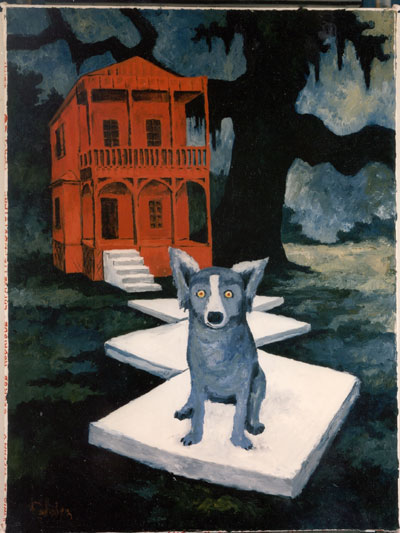 |
In Rodrigue’s landscape schema, the oak tree was the central and constant element. In the paintings done between 1984 and 1990, the oak tree was joined by the dog (Freundlich, 1996, pp 157, 159, 161); together they are the constants. And then, in 1990, the landscape schema (oak tree and all) disappeared — but the dog remained. Here was a new schema : it was composed of a blue dog in the foreground or occupying center stage, always in the full-frontal posture, gazing unwaveringly, unmovingly at the viewer at eye-level. "I put the dog at eye-level like a person... you’re not looking down at the dog...".
[21]
In this new schema, it is the dog that is the constant; the background and the rest of the picture will change from one painting to another (Danto & Rodrigue, 2003, pp 108, 116).
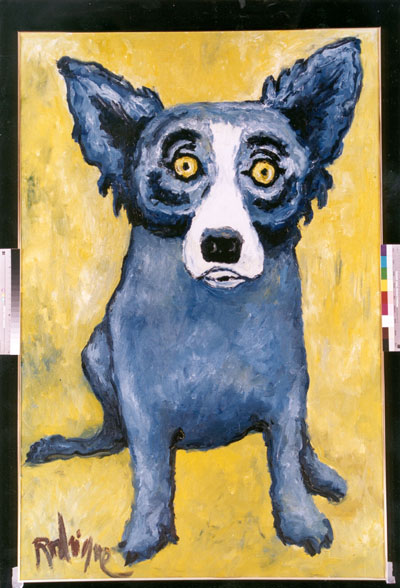 |
As already noted, Rodrigue’s Cajun landscapes were instantiations of the landscape schema. When he decided to paint people or other figures, he wanted to subjects that were entrenched in Cajun culture. And, as before, he wanted to paint them "differently".
[22]
Some of Rodrigue’s earliest figural paintings (done in 1971) were on the theme of ‘Evangeline’, yet another subject of Cajun folklore, associated with the history of the Cajun people (Brasseaux, 1988; ; Hawthorne & Dana, 1947) -- and best known to the world through Henry Wadsworth Longfellow’s poem Evangeline. These paintings represent in their very designs a way of enriching the Cajun landscape schema. The figure of Evangeline appears to interrupt the landscape — as if she had been created elsewhere, cut out, and pasted onto the landscape. If the viewer imagines away the Evangeline figure, what remains are different instantiations of the landscape schema. Yet, the effect is more subtle than that of a pasted cut-out. In these paintings, the feet are invisible. Evangeline seems to be floating in the foreground. This effect is enhanced by the fact that her hair is sometimes part of the foliage ( see also Freundlich, 1996, pp 78; Danto & Rodrigue, 2003, pp 50-51).
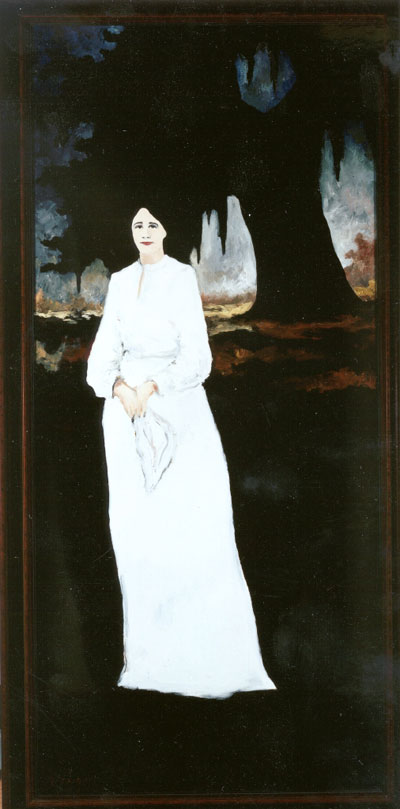 |
This idea of figures interrupting the landscape is a theme that appears in other paintings Rodrigue did at about the same time he painted the early Evangelines — and in the years that followed. Even his nudes manifest this strategy (Freundlich, 1996, p. 108).
Interrupting the landscape with images that simultaneously seem to be cut-and-pasted and suspended thus emerged as a new figural schema. Rodrigue achieved this effect by using several techniques: contrasting black against white, deploying hard edges to separate figure from ground, dissolving the figure’s head into the darkness of the background (usually oak trees) to form a continuity, and (in the case of female figures) hiding their feet (see also Danto & Rodrigue, 2003, pp 50, 52, 56-57). They were all design strategies — aspects of Rodrigue’s evolving cognitive style.
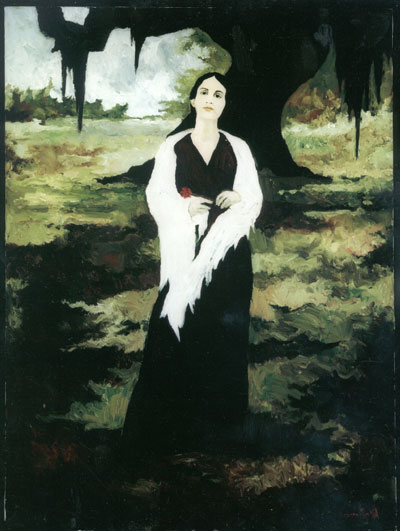 |
As Bell (1999) has pointed out, the two-dimensional shapes and marks on a canvas collectively produce a pictorial representation. In the case of Rodrigue’s Evangeline paintings, the canvases are pictorial representations of a woman in white standing or sitting against the dark background of an oak tree.
But Bell also noted that a painting has a meaning. It is about something. Rodrigue’s Evangeline is a symbolic representation of the "whole Cajun culture", the "mysterious... haunting feeling of people suspended in time and space" (Rodrigue, 1976, p. 2).
As pictorial representations, the Evangeline paintings differ from each other in that both foreground figures and background landscapes differ from one picture to another. Yet in another sense, the pictorial representations are similar, because they are based on the same pictorial schema : both are instantiations of the same landscape/figural schema complex.
Moreover, the paintings are representations in another sense. They express or represent the artist’s feelings about the history of the Cajun people. They both represent similar emotions. In this sense, each picture is a symbolic representation of a common emotion felt by the artist.
How did Rodrigue realize this kind of symbolic representation? On the one hand, the woman in white is not any woman in white (Fig. 8); she represents ‘Evangeline’ — the character of the Cajun myth. Rodrigue’s mental representation of the Evangeline myth — stored in his knowledge base — must have included the imagined maiden’s hopes, fears, expectations, her feeling of love for her lost lover, and so on. Thus, the woman in white is what Freud would have called a condensation, in Rodrigue’s mind, of an entire complex of ideas, emotions, and feelings associated with Evangeline.
On another level, the Evangeline myth as a whole symbolizes the Cajun past. For Rodrigue, the myth is itself a symbolic representation of Cajun history.
Thus, Rodrigue’s Evangeline paintings are visualizations — physical symbolic representations — of his mental symbolic representation. He achieved this by employing particular pictorial elements to represent aspects of his mental representations.
Thus, Rodrigue’s landscape schema consisted of a jagged-edged, silhouetted oak tree, an enclosed sky, a dark foreground. Each of these elements is a symbol: the oak tree is a condensation of the South Louisiana landscape; the enclosed sky represents Rodrigue’s sense of the Cajuns being "locked in" (Rodrigue, 1976, pp ix-x); the almost black foreground and foliage also represents the artist’s feelings of the closedness of the Louisiana landscape. The landscape schema itself is a symbolic representation of the "basic traits" of Louisiana (Figs. 3,5).
Likewise, the figure of Evangeline, her symbolic role in expressing the early history of the Cajuns and Rodrigue’s "haunting feeling" are achieved by such pictorial elements as the invisible feet and the dissolution of the black hair into the black background foliage (Figs.8, 9).
13. The Blue Dog as symbol
As for the Blue Dog schema, it became a symbol of Rodrigue’s liberation from his Cajun environment: "it got to be modern... it was a reflection of society versus a reflection of Louisiana... it walked out into the world."
[23]
Armed with the Blue Dog, "I could comment on everything... I could take it anywhere... I could put it on the moon...".
[24]
... I was painting Cajuns as a cultural expression... and
then when the Blue Dog came the art part took over...
took me over... it released me of all other things, all the
baggage I had as a Cajun... because I could take it anywhere
... it was exciting...
[25]
Even the dog’s immobility symbolized something : "it’s in the same position... because if it was in different positions [you] would say it’s moving... when it’s rigid it’s moving in the mind".
[26]
There is yet another level of symbolism in the Blue Dog : it came to represent the artist himself.
...I put the Blue Dog as commenting on life today...
in other words, here she is sitting there looking at life
... and it’s me reflecting on where I am or where we are
as a society and so in that way it became bigger than a
Cajun legend or whatever it was before and it’s actually
me... reflecting on a situation or mankind or whatever
it is...
[27]
To painters colors are symbols; they too represent. For Matisse (1968, p.134) , "The chief aim of color should be to serve expressions". For Kandinski (1977, p. 19), white and black carried definite meanings in his paintings : white symbolized "the harmony of silence... not a dead silence but one pregnant with possibilities", while black symbolized a "totally dead silence... the silence of death".
The colors black and white also represent for Rodrigue:
Now I paint neither bayou nor road. They both look the
same, and they are black. To me this blackness represents
the path and this path leads to the white sky, to the hope.
The white of the people indicate the same hope, for the
people also have to have hope for themselves...
[28]
But an entity can serve as more than one kind of symbol in art; in different contexts it can represent different things, as noted by Matisse (1968). So also for Rodrigue : black represented both the path to hope and the closedness, the locked-in quality of the Cajuns who came to Louisiana as exiles; white symbolized hope and also the ghostliness of his figures, for they belonged to the past (Rodrigue, 1976, p.xi).
In the case of the Blue Dog, the color blue is, of course, at the very heart of his schema. Just as black and white served as color symbols in the ‘Cajun paintings’, so also did blue in the Blue Dog works.
The antecedents of the Blue Dog — the paintings inspired by the Cajun mythical werewolf Loup-garou — were "greenish-bluish-grey" (Fig. 6). But once the Blue Dog emerged — when Rodrigue realized that "it wasn’t a dog anymore, it was more me" — he selected blue because just as white had given the Cajun figures a "cut out" feel, so also blue "had the same feeling" — it wasn’t associated with the rest of the schema.
... blue became more powerful in itself because... it
was not in everything else... if it was green you’d have
it in landscape... I didn’t want it in white because the
Cajuns were white... [it] had to be something else...
more striking, more powerful... abstract... idea-wise
graphic-wise... the brighter it got the better I liked it.
[29]
Thus, the color blue symbolized the abstractness of the dog, its apartness from everything else, both as an idea and from a strictly graphical point of view (see also Danto & Rodrigue, 2003, pp. 170-171).
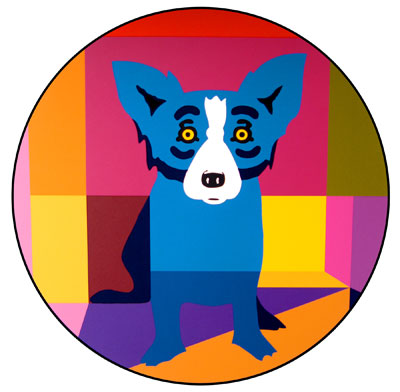 |
The Blue Dog schema, then, is not just the shape of the dog; it is not just the color; nor just the immobility. It is certainly all of these, but it is also significant in its symbolism, in what it represents. And just as the shape and color and features evolved from the Loup-garou to the Blue Dog, so also the symbolism evolved. As a result, the Blue Dog schema also evolved over time.
15. Rodrigue’s symbols: the case of God Bless America (2001)
The extent to which colors and other pictorial elements symbolized a synergy of ideas and emotions in Rodrigue’s art is exemplified rather dramatically by his God Bless America (2001) — about which he would write:
On the night of September 11, 2001, like Americans
everywhere, I sat in shock over the events of the day. As
I’ve done many times in my life, I turned to my easel and
paints for comfort.
At 5 a.m. I stared with my wife at the painting I’d
just finished. As we looked from each other to the canvas,
we knew that I’d made a powerful and accurate statement
of both our feelings.
[30]
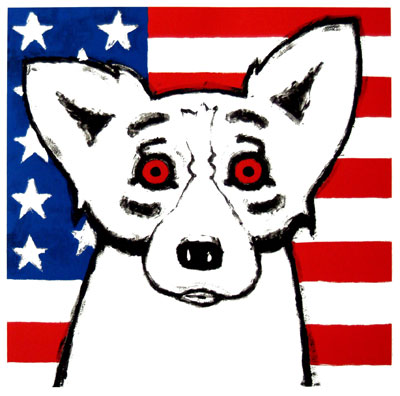 |
The picture shows the familiar Blue Dog — except that the dog is not blue. She is Blue Dog but divested of all color. Rather, she is a kind of wishy-washy white or grey. And instead of the familiar yellow eyes, her eyes are red. A colorless Blue Dog with bloodshot eyes.
Behind the dog is the American flag. A national flag has many meanings: it represents a country; it is a marker of national identity and pride; an expression of patriotism; a symbol of defiance against the enemy. In this work the flag symbolizes all of these. It represents — is — America. As for the colors:
I first thought to paint the dog black. Instead I painted it
without color at all, the blue joy drained by shock and grief
... For many years, the dog had had happy yellow eyes. On
this day however, the eyes are red, indicating a heavy heart.
[31]
The red eyes remind us that an early precursor of Blue Dog was Rodrigue’s incarnation of the mythical werewolf Loup-garou — whose eyes he painted red. Was Rodrigue harking back to the primeval animal when he painted the colorless Blue Dog’s eyes red?
In Aoli Dinner (1971), one of Rodrigue’s earliest oils of a scene from Cajun life, the faces of the people are the faces of individuals; they are distinguishable. In contrast, in other paintings done the same year the faces of the people are almost indistinguishable — as if they are wearing identical masks.
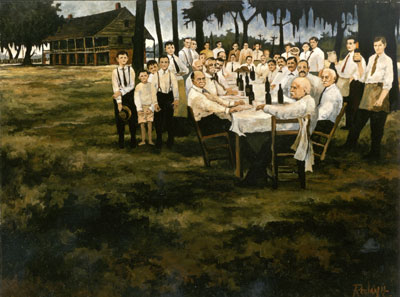 |
By 1973, the face has turned into a mask. The four women in John Courrege’s Pirogue (1973) (Freundlich, 1996, p. 87) ‘wear’ the same face. The effect is still more pronounced in Miss Arsenaux’s Girls’ School (1973) in which all the girls wear the same mask-like face as do the boys, as do the teachers.
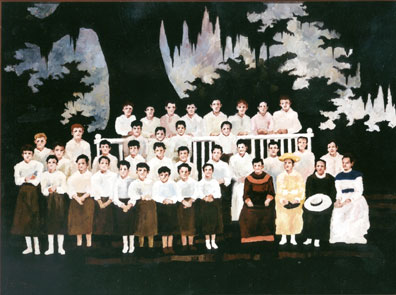 |
Gombrich (1972, pp 9-10) has noted how our normal capacity to recognize the constancies of a face across changes of mood and age can be blocked so easily by "what may be called the mask" — "the crude type of likeness which can throw the whole mechanism of physiognomic recognition into confusion".
In the realm of painting, this point is particularly significant : the mask can obliterate a subject’s physiognomic features and, with them, any possibility of ‘knowing’ the person. The mask can, in fact, ‘depersonalize’ the artist’s subject, as may be seen in Picasso’s Portrait of Gertrude Stein (1905-06) or Matisse’s Portrait of Madame Matisse (1913). In the words of Cowling (2000, p.13), the "inscrutable, distancing, generalizing mask" for both these artists, became part of their respective artistic repertoires.
Cowling’s words are especially apt in the case of Rodrigue’s pictures of the Cajun people. Sometimes, it is not just their dresses that render them almost indistinguishable, but their faces also. They are less faces than masks.
But what are the masks for? Perhaps, like the landscape and the figural schemas (indeed, they are elements of the latter), they too symbolize an aspect of the Cajun historical circumstance. Perhaps they are intended to project the same sense of hauntedness that the schemas project. Certainly, the mask-like face distances the viewer from the subject. She cannot fathom their emotions.
That artist rely on visual memory is well known. Harding (1942) documented many instances of painters who created ‘pictorial memoranda’ as an aid to visual memory. She also made the distinction between ‘scientific’ and ‘poetic’ painters. The former desires to capture aspects of nature as faithfully as they can; the latter looks to nature as a source of ideas and inspirations for expressing their "poetic dream" (p. 80). Furthermore, in the most extreme case, the ‘scientific’ painter does not need pictorial memoranda as aids to visual memory. In contrast the ‘poetic’ painter (in Harding’s sense) paints not so much from nature but from his visual memory of nature, and to this end he creates pictorial memoranda as an aide memoire.
Thus, Camille Corot kept "copies of my works in my heart and in my eyes". "A landscape painter should be able to paint a country masterpiece without leaving Montmartre" (Quoted in Harding, 1942, p. 82) Francois Millet would make sketches outlining the main features of a figure or landscape, then do the complete painting afterwards in the studio, relying on his memory to capture atmospheric and other effects (Harding, 1942, p. 82). J.W.M. Turner would make copious studies from nature, but in his final paintings he would change them quite dramatically. Even Turner’s contemporary, John Constable, though known to be committed to painting landscapes based on "a pure apprehension of natural effect", would make countless oil sketches out of doors but would paint the final version in his studio (Jansen, 1969, p. 469).
The advent of photography brought its own challenges to the naturalist painter. But the camera also provided a new tool for creating visual memory. Picasso, for instance, enthusiastically adopted the then quite new technology of photography to build pictorial memoranda. Indeed, he used the camera as an experimental research tool to explore perception, visual illusion and the ‘geometrization of nature’ (Miller, 2001, pp 141-152).
In Harding’s (1942) parlance Rodrigue is a ‘poetic’ painter in whom visual images, impressions and emotions are transformed into designs. Like other ‘poetic’ painters before him, Rodrigue created his own pictorial memoranda as aids to visual memory. He resorted to the camera. Photographs served as ‘pictorial data’ — much as the scientist and the scholar gathers data — that entered into his work.
Visiting Santa Fe, New Mexico in the late 1980s, Rodrigue met a young Native American woman named Evergreen Lake. He decided to paint her and visited Santa Fe several times to photograph her.
[32]
The photographs show her in many different dresses. In fact, Rodrigue photographed her in as many as nine distinct combinations of dresses and poses. These slides constitute a series of visual and compositional experiments. The parameters are particular design elements : pose, dress design, scarf, color combination in the dress, background. The paintings with Evergreen Lake as model (Freundlich, 1996, pp 143, 152) draw upon these experiments, select combinations of the design elements, and transform them in the act of painting.
If the Evangeline myth symbolized the Cajun past, the folk song Jolie Blonde is embedded in modern Cajun popular culture. The song, set to a waltz and written in 1928, is a prisoner’s lament at the loss of his unfaithful girl. According to Ancelet (1989), this theme of a prisoner’s farewell, of unfaithfulness, and of lost love was well entrenched in the repertoire of Cajun music. When Rodrigue first began to people his Louisiana landscape, the Jolie Blonde theme attracted him because of its familiarity within the Cajun culture. As in the case of Evangeline, Rodrigue would return to the Jolie Blonde theme repeatedly.
Here also, he conducted visual experiments and recorded them photographically as pictorial memoranda. In this case he made at least thirty five photographic slides of the same model. She had blonde hair and wore the same blue frock with shoulder straps and a white sash round the waist. In some pictures she wore a wide-brimmed straw hat, in others she was bare-headed. Some showed her sitting in various poses and angles, others had her standing. In some she held a stem with a single red rose, in others she held the hat. A few were close-ups of just her face, others were bust-length pictures. Still others showed her in full figure.
These visual experiments provide pictorial data; the paintings themselves manifest specific design elements from some of the slides, some from other slides. Rodrigue adapted them to his figural schema and in this process, he instantiated the schema in various ways.
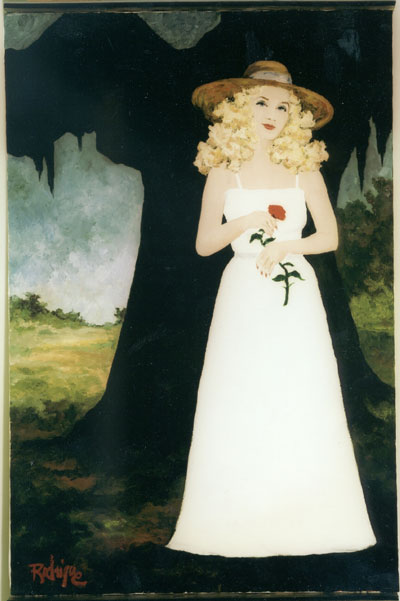 |
18. Instantiation of a cognitive style : watching Rodrigue paint
How does a person’s cognitive style get instantiated in any particular act of creation? In the case of Rodrigue, we had the opportunity of observing him paint and have the process videotaped.
[33]
Later, watching the videotape, it became apparent that we were witnessing an instance of Rodrigue’s cognitive style unfolding in real time.
For about two months prior to the videotaping session, Rodrigue had been painting a series of very abstract oils, mostly on large circular canvases. These were his ‘hurricane’ paintings and they began almost immediately after he had lived through a major hurricane that had passed through South Louisiana.
He had, in fact, invented another schema which we may call the hurricane schema. Its main features were the presence of whirling, swirling, darting spiral shapes in various vivid colors, intermingling with one another — and the absence of hard edges.
A transcript of our audiotaped commentary of what is recorded in the videotape is presented in the Appendix below. What the videotape shows is how one particular aspect of Rodrigue’s cognitive style — the mutual interaction between, and the mutual interruption of, two schemas — comes into effect in one act of painting. The resulting picture, later titled Collision (2002) (see also Danto & Rodrigue, 2003, pp 244-245) entailed both the instantiation of the Blue Dog and hurricane schemas, but in a manner in which each of the instantiations influenced and was informed by the other. We observe the following general cognitive features of this particular process .
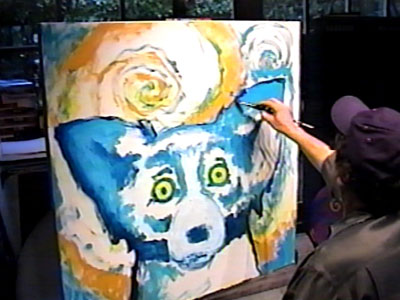 |
One. It was goal driven. It began with Rodrigue’s conscious intention to paint a picture that would place the Blue Dog against a hurricane. Rodrigue’s knowledge system/worldview contained the hurricane and Blue Dog schemas; they also contained images of the many instantiations of the Blue Dog schema done since the early 1990s, as well as images of the very recent hurricane paintings. The picture he embarked on would integrate instantiations of the two schemas.
Two. Rodrigue did not focus exclusively on the one or the other for significant periods of time; his focus on any one of the two schemas stayed for periods that ranged for a few seconds to a few minutes before attention switched. Thus, he painted the vague outline of the Blue Dog and then the vague hints of the spiraling hurricane. The painting then proceeded by shifting constantly back and forth between the two, refining and elaborating and enriching each. The two schemas are instantiated in a fine-grained, time-interleaved manner.
Three. The two instantiations communicated with each other. In the videotape he stated: "All these colors influence each other". We find clear evidence of this : having created the first blue outline of the dog, the same blue went into the first outline of the hurricane; yellow blobs for the eyes and then the same yellow was added to the hurricane, and then he shifted back to the eyes and to the hurricane, adding the same yellow to one and then to the other. The white was used on the dog’s nose and was then added to the background, then used on the dog again, and again on the background. Dark blue was used to give sharper shape to the nose, and then was added to the orange-yellow background. Light blue was used for the ears and was then added to the hurricane. And at the end, Rodrigue mixed light blue and white and painted over a part of the Blue Dog and then over parts of the hurricane.
Four. Despite the purposive nature of the overall process, Rodrigue disavowed prior knowledge of the final state of the picture: "I have no idea what it’ll look like when it’s finished", he comments in the videotape; and again, "I have no idea where it’s gonna go". Watching the process unfold — observing the way in which the actions of one moment influenced the next, and the fact that the two instantiations communicate with each other — we find this very plausible.
In fact, the process of the time-interleaved instantiations of the two schemas conform to the notion of situated action (Suchman, 1987) : at each stage, the state of the canvas and the decision to add something to the picture or to change something — in Suchman’s terms, the "circumstances" of the moment — influenced the next step.
The main elements of Rodrigue’s cognitive style can be summarized as follows. (a) The invention-by-purposive-evolution of several schemas. (b) The strategy of schemas interrupting and interacting with each other. (In the case of painting Collision, the interaction was in the form of a fine-grained time-interleaved process; moreover, the process unfolded in the form of a sequence of situated actions.) (c) The use of forms, colors, and particular entities as symbolic representations of feelings, emotions and perceptions. (d) Building pictorial memoranda by way of photographic experiments. (e) A knowledge system and world view that encoded a strong sensibility toward the history, geography and culture of the Cajun peoples and country. (f) Bisociative synthesis involving the techniques of Abstract Expressionism and Pop Art on the one hand, and his knowledge and perception of South Louisiana on the other.
Clearly, some of these elements in isolation are not unique to Rodrigue. For instance, Gombrich (1969) has written extensively on the use of schemas by artists throughout history. Gage (1999) has written on how colors serve to symbolize or ‘mean’; we have seen Matisse’s and Kandinsky’s thoughts on this same topic. And recently, Pastoureau (2001) has developed the significance of a single color, blue, in the history of culture. We have also noted that other artist’s, such as Picasso and Matisse, have deployed the mask as a way of depersonalizing a subject’s face. Finally, there is extensive documentation of artists preparing compositional studies similar to the photographic experiments conducted by Rodrigue.
The uniqueness of Rodrigue’s cognitive style — and our ‘understanding’ of this artist — lies in part in the particular combination of these elements and in part in the specificity of the individual elements. In particular, Rodrigue’s originality is attributable to the specificity of his three principal schemas — landscape, figural, and Blue Dog — and the way in which he induces the schemas to interrupt and interact with one another; and in his specific symbology — his use of the colors, the shape of his figures, the immobility of the dog. These are what makes Rodrigue’s pictures ‘unmistakably Rodrigues’.
Here, we are reminded that in the case of Herbert Simon, many of the individual elements of Simon’s cognitive style were also not unique to him. It was the way these various elements combined with each other, dynamically, and thus formed a coherent whole that enabled him to achieve his multidisciplinary creativity (Dasgupta, 2003a).
Rodrigue’s cognitive style did not emerge abruptly in toto. Nor did it emerge de novo. There was a prehistory to it as well as a history. The former denotes the existence of a ‘prepared mind’ — specifically what we have called ‘proactive preparation’ — and the latter denotes the fact that the cognitive style both evolved purposefully, and was enriched and elaborated over time. In particular, Rodrigue’s schemas, symbols and representations took time to form.
Finally, we observe that once a schema had developed, particular paintings were elaborations, refinements, and instantiations of that schema, in a way that no two paintings are identical. None of Rodrigue’s landscapes is identical to any other landscape. More interestingly, none is exactly identical to the schema. Yet they bear a ‘family resemblance’. Likewise, no two Blue Dog paintings are identical; each takes the schema and then deviates from it and builds upon it.
20. Conclusions
An artist’s individual style is of great interest to art historians and art critics. It characterizes the uniqueness of the artist and also allows one to ‘place’ him in the overall historical scheme.
This individual style, as expressed by the physical productions of the artist, is both part, and a manifestation, of a more general characteristic which is called ‘cognitive style’ here. As noted in section 1, a creative person’s cognitive style is composed of particular features or regularities that appear to underpin his cognitive processes of creation. Our ‘understanding’ of an artist’s creative life may be greatly enhanced if we are able to identify his or her cognitive style. This was the main aim of this work, in the case of George Rodrigue, using the method of cognitive history.
But there is a larger issue at hand. Delineating cognitive styles of different artists may allow us to compare them from a cognitive perspective. Or still more generally, investigating cognitive styles across creative traditions (e.g., art, science, literature) might shed light into the commonalities and differences of these various traditions, again from a cognitive perspective. Our hope is that the present study, when juxtaposed against others conducted in the realms of science, literature and technology -- see, e.g., our study of the cognitive style underlying the polymath scientist Herbert Simon’s multidisciplinary creativity (Dasgupta, 2003a) -- will contribute to a comparative study of cognitive styles.
Appendix : Transcription of an audiotaped commentary of a videotape recording of George Rodrigue at work on a painting titled later Collision. Italicized segement in ‘[...]’ are additional explanatory remarks.
Rodrigue has selected a largish square canvas... [he says that he will do a painting that has both Blue Dog and hurricane ]... he presses out light blue, yellow and white paint from tubes onto palette [ these are the colors of the Blue Dog ]... the outline of the dog in blue paint is done — the tips of the head and ears, and the shape of the nose... he then uses the blue for a spiral shape in the background... [ the shape of the dog occupies the lower half of the canvas; clearly, only the head and neck will show ]... He then profiles the dog in a darker blue... he focuses on the face and head — the eyes and ears, then yellow blobs for the eyes... he uses the yellow to add to the spiral in the background, and then to the eyes again, a darker yellow, then back to yellow in the hurricane spiral, more yellow for the background behind the dog’s neck... he returns to the dog, sharpens the nose outline with dark blue, and uses blue for the lines of the eye and other parts of the head... he then takes white paint from the palette and fills the nose part, then uses the white to fill an empty part of the canvas, then back to the dog, white surrounding the tip of the nose, white just below the eyes, then to give more substance to the head — the nose and upto the forehead... the white fills the canvas background near the ears... Rodrigue takes orange paint and colors the background, spirals surrounding and mingling with the yellow spirals... [ the hurricane is taking shape ]... another color — it looks like yellow ochre — is used to fill part of the lower canvas behind and beyond the dog’s neck area... he returns to the blue — dark blue is used to give more shape to the nose, then to the orange yellow background... then the lighter blue to fill the dog’s head... then dark blue to the outline of the eyes [where it mixes with the yellow and becomes green ]... adds the twirls to the eyes, then paints the pupils [ which also comes out green in combination with yellow ]... adds blue to the top of the head... more blue to the background [ which is now a blue-green-orange-yellow complex ]... he switches to the light blue, fills the ears... [ at this stage the dog is a combination of blue part of the ears, blue nose with white inside, parts of the eyes are blue, yellow eyes with greenish circumference and greenish pupils... the neck is still without paint ]... the outer shape of the dog is sharpened with the dark blue... he takes white to color the nose, more white for the bridge of the nose and the tip... dark blue to sharpen the shape of the dog’s head, then dark blue inside over the previous light blue for the inside of the ear... then light blue for the body of the ear and fragments of light blue to the background — blue swirls, combines with the orange... more of the dark blue to sharpen the edges of the ears and central part of the ears, bits and pieces of dark blue to the dog’s contours and to parts of the face... he takes white and adds it to the area surrounding the nose, then fills in the nose with white... more light blue added to the top of the head and the ears... [ the dog is now almost Blue Dog ]... Rodrigue switches to yellow — and the background... he fills in almost all the hurricane with yellow [which is now a complex of yellow, orange, and blue, with the yellow-orange dominating ]... more body to the background with the space on the left canvas filled with ornage-yellow... [ the state of the canvas : an almost complete Blue Dog and a hurricane background, mostly yellow-orange with a bit of blue, and some empty canvas ]... switches to white for the nose and mouth... takes black — to give harder form to the eyes’ circular shape, and then the pupils, and the hooks above the eyes... [ the edge of the eyes is now black-green with the rest yellow ]... more black is added to the other eye, then black to the nose, to the ear-holes... dark blue is used for parts of the ear meeting the muzzle part, dark blue to give shape to ear-holes and eyebrows, dark blue to deepen the blue below the nose and the mouth, the neck... switching to light blue below the nose and mouth and empty spaces in the neck area, the area below the eyes, then the ears... white is added to the nose... Rodrigue is now filling in the dog mostly with the lighter blue, sometimes with dark blue for the edges, filling in gaps on the two sides of the nose... he switches to the hurricane and adds lines and masses of orange, overlaying the yellow with orange, and filling in the little spaces of the hurricane with orange... he takes yellow and overlays the orange... [ at this stage, Rodrigue stops, pushes his chair back, looks at the canvas, and then talks about the painting : "... all these colors influence each other... this blue is influenced by this color... so these areas are really important... all these colors influence this color... when started I did not know what I’d do... this color back here is influencing this... so tomorrow I’ll come back and see... I have no idea what it’ll look like when it’s finished"... he then continues : "... I have no idea where it’s gonna go... that’s why I keep it open till the very end... I keep all my options open... I could draw it out and paint the whole thing blue and then... the background and paint it all yellow... but then you have no options... I leave myself some time to do something else... if I develop it the same way each time I paint blue and yellow or whatever, then I’m stuck with the seven or eight color periods... so it’s all open now still... " ]... Rodrigue returns to the canvas... he mixes some light blue and white and paints over some of the dog and also over the hurricane area... a greenish tint results from that... he overpaints a part of the orange in the hurricane area... he then adds dark blue to the tip of the ears and the top of the head, sharpening and darkening the edges of the ear...
[1]
George. Rodrigue, personal communication, email, April 17, 2002.
[2]
Now the University of Louisiana at Lafayette.
[3]
George Rodrigue, personal communication, email, April 17, 2002.
[4]
George Rodrigue, personal communication, email, April 27, 2002.
[5]
George Rodrigue, personal communication, email, March 6, 2002.
[6]
George Rodrigue, personal communication, email, April 17, 2002.
[7]
George Rodrigue, personal communication, email, April 22, 2002.
[8]
George Rodrigue, letter to Thomas Sokolowski, October 6, 2001.
[9]
George Rodrigue, audiotaped interview, Sept. 30, 2002.
[10]
Ibid.
[11]
George Rodrigue, personal communication, email, April 17, 2002.
[12]
George Rodrigue, Letter to Thomas Sokolowski, October 6, 2001.
[13]
George Rodrigue, audiotaped interview, September 30, 2002. Lafayette, Louisiana.
[14]
Ibid.
[15]
Ibid.
[16]
George Rodrigue, personal communication, email, April 17, 2002.
[17]
George Rodrigue, audiotaped interview, September 30, 2002. Lafayette, Louisiana.
[18]
Ibid.
[19]
Ibid.
[20]
George Rodrigue, audiotaped interview, December 13, 2002, Lafayette, Louisiana.
[21]
Ibid.
[22]
George Rodrigue, audiotaped interview, September. 30, 2002, Lafayette, Louisiana.
[23]
Geirge Rodrigue, audiotaped interview, December 13, 2002. Lafayette, Louisiana.
[24]
Ibid.
[25]
Ibid.
[26]
Ibid.
[27]
Ibid.
[28]
Ibid.
[29]
Ibid.
[30] George Rodrigue, commentary on God Bless America, personal communication, email, March 6, 2002. (Back to Main Text)
[31]
Ibid.
[32] George Rodrigue, personal communication, May 29, 2002.(Back to Main Text)
[33] J. Dasgupta, Videotape of G. Rodrigue, December. 23, 2002. Lafayette, Louisiana. (Back to Main Text)
Acknowledgements
This work, conducted in 2001-2003, could not have been possible without the cooperation of George and Wendy Rodrigue. Mr. Rodrigue readily gave of his time to be interviewed, videotaped, and to answer my questions, in his studios in Lafayette, Louisiana and Carmel, California, by telephone and by email. Mrs. Rodrigue transcribed several of George Rodrigue’s verbal responses in a form that I could use. They both gave me free access to the artist’s personal archive of slides and photographs of his work stretching over almost forty years. Except for the picture of Mr. Rodrigue and the image of Collision-in-progress, all the images are from copyrighted material belonging to Mr. Rodrigue. I thank him for permitting me to use these images.
I must thank my colleague Dr. Henry Chu for his invaluable assistance in preparing the figures. My thanks also to Mr. Scott Wilson for his help in preparing stills from the videotape.
References
Ancelet, B. (1989). Cajun music : Its origin and development. Lafayette, LA: University of Louisiana at Lafayette, Center for Louisiana Studies.
Arbib, M.A. & Hesse, M.B. (1986). The construction of reality. Cambridge : Cambridge University Press.
Arnheim, R. (1962). Picasso’s Guernica : Genesis of a painting. Berkeley, CA: University of California Press.
Bartlett, F.C. (1932). Remembering. Cambridge, England : Cambridge University Press.
Bell, J. (1999). What is painting? London : Thames & Hudson.
Brasseaux, C.A. (1988). In search of Evangeline. Thibodeaux, LA : Blue Heron Press.
Chipp, H.B. (1968). Theories of modern art. Berkeley, CA: University of California Press.
Cowling, E. (2000). Interpreting Matisse Picasso. London : The Tate Gallery.
Danto, G. & Rodrigue, G. (2003). The art of George Rodrigue. New York : Harry N. Abrams.
Dasgupta, S. (1991). Design theory and computer science. Cambridge, England : Cambridge University Press.
Dasgupta, S. (1999). Jagadis Chandra Bose and the Indian response to western science. Delhi : Oxford University Press.
Dasgupta, S. (2003a). Multidisciplinary creativity : the case of Herbert A. Simon. Cognitive Science, 27, 683-707.
Dasgupta, S. (2003b). Innovation in the social sciences: Herbert A. Simon and the birth of a research tradition (pp 458-470), in L. Shavinina (Ed.) International handbook on innovation. Kidlington, Oxford : Elsevier Science.
Dasgupta, S. (2004). Is creativity a Darwinian process? Creativity Research Journal, 16 (4), 403-413.
Davidson, A.I. (1999). Styles of reasoning, conceptual history and the emergence of psychiatry. In M. Biagoli (Ed.) The science studies reader (pp 124-136). New York : Routledge.
Freud, S. (2001). Leonardo da Vinci : A memoir of his childhood (1922) . London : Routledge.
Freundlich, L. (1996). George Rodrigue: A Cajun Artist. New York: Viking Penguin.
Gage, J. (1999). Color and meaning. Berkeley, CA: University of California Press.
Gaiger, J. (2002). The analysis of pictorial style. British Journal of Aesthetics. 42 (1), 20-36.
Gombrich, E.H. (1969). Art and illusion. Princeton : Princeton University Press.
Gombrich, E.H. (1972). The mask and the face: The perception of physiognomic likeness in life and art (pp 1-46), in E. Gombrich, J. Hochberg & M. Black. Art, perception and reality. Baltimore, MD : Johns Hopkins University Press.
Gruber, H.E. (1974). Darwin on man. Chicago : University of Chicago Press.
Gruber, H.E. (1989). The evolving systems approach to creative work (pp 3-24) in Wallace & Gruber (1989).
Harding, R. (1942). An anatomy of inspiration. Cambridge : W. Heffer & Sons.
Hawthorne, M. & Dana, H.W.L. (1947). The origin and development of Longfellow’s "Evangeline". Portland, OR : The Anthoensen Press.
Holmes, F.L. (1989). Antoine Lavoisier and Hans Krebs : Two styles of scientific creativity (pp 44-68), in Wallace and Gruber (1989).
Ippolito, M.F. (2003). The journey to Jacob’s Room : The network of enterprise of Virginia Woolf’s first experimental novel. Creativity Research Journal, 15 (1), 24-44.
Jansen, H.W. (1969). History of art. New York : Harry N. Abrams.
Jeffrey, L. (1989). Writing and re-writing poetry : William Wordsworth (pp 44-68), in Wallace & Gruber (1989).
Kandinsky, W. (1977). Concerning the spiritual in art (1914). New York : Dover Publications.
Koestler, A. (1964). The act of creation. London : Hutchinson.
Kris, E. (1952). Psychoanalytical explorations of art. Madison, WI : International Universities Press.
Lowes, J.L. (1927). The road to Xanadu.. Boston : Houghton-Mifflin.
Matisse, H. (1968a). Notes of a painter (1908), (pp 130-136), in Chipp (1968).
Matisse, H. (1968b). Testimonial (1952) (pp 141-143). In Chipp (1968).
Miller, A.I. (2001). Einstein Picasso. New York : Basic Books.
Nersessian, N. (1995). Opening the black box : Cognitive science and history of science. Osiris (10, 2nd series), 194-215.
Pastoureau, M. (2001). Blue : The history of a color. Princeton & Oxford : Oxford University Press.
Poincare, H. (1980). Mathematical creation (1915) (pp 22-31), in B. Ghiselin. The creative process. Berkeley : University of California Press.
Robinson, J. (1981). Style and significance in art history and art criticism. Journal of Aesthetics and Art Criticism, 40 (1), 5-14.
Rodrigue, G. (1976). The Cajuns of George Rodrigue. (G. & J. Planel, tr.) Birmingham, AL : Oxmoor House.
Rubin, W., Sekel, H. & Cousins, J. (1994). Les demoiselles d’Avignon. New York : Museum of Modern Art.
Simon, H.A. (1975). Style in design (pp 287-309), in C.M. Eastman (Ed.) Spatial synthesis in computer-aided design. New York : Wiley.
Suchman, L. (1987). Plans and situated actions. Cambridge, England : Cambridge University Press.
Tweney, R. (1989). Fields of enterprise: On Michael Faraday’s thought (pp 91-106), in Wallace & Gruber (1989).
Wallace, D.B. & Gruber, H.E. (1989). Creative people at work. New York : Oxford University Press.
Wallas, G. (1926). The art of thought. New York : Harcourt, Brace & Co.
Weber, R.J. & Perkins, D.N. (1992). Inventive minds : Creativity in technology. New York : Oxford University Press.
Wiesendanger, M, & Wiesendanger, M. (1971). The 19th century Louisiana painter and paintings. (New Orleans : W.E. Grove Gallery).
Wollheim, R. (1984). Painting as an art. Princeton : Princeton University Press.
Received: January 1, 2005, Published: January 1, 2005. Copyright © 2005 Subrata Dasgupta
